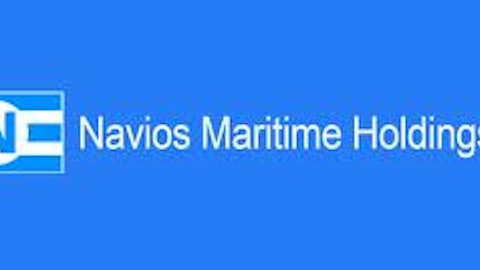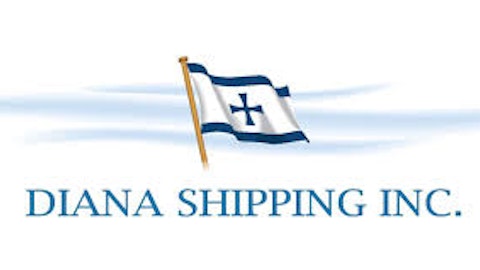Over the past few years, amid a global slump in demand for dry bulk commodities and a disturbing tonnage oversupply, the marine transportation business has not been on fire. The dry bulk market has a long way to go before it can exit risk territory. But the year-to-date run-up in many shipping stocks, as well as analysts’ expectations for a substantial lift in Chinese iron ore imports, suggest that there might be light at the end of the tunnel after all.

I have to admit there’s some truth to this bullish sentiment, and there are a few industry players who are most definitely worth keeping an eye on for the long term. Yet I think that ship owners have huge mountains to tackle ahead of them.
Let’s see what three recent earnings reports have to tell us about fundamental puzzles within the industry:
DryShips Inc. (NASDAQ:DRYS): The disruptive implications of debt overload
Last week, DryShips Inc. (NASDAQ:DRYS) — perhaps the most controversial player in the space — reported earnings for the first calendar quarter of 2013. For the period, the shipper witnessed its net income hit rock-bottom levels, decimated by the sale of four new buildings. Revenue from charters for its dry bulk fleet nearly halved compared to the same period in 2012, while its overall net losses came in at $116.6 million, or $0.30 a share.
Fundamentally, the shipper is not looking good. To its credit, it has been making every effort to reduce its capital expenditures and remedy its liquidity weakness. However, thus far these efforts have been rather painful. During the quarter, just to get rid of some of its newbuilding dry bulk vessels, it had to suffer losses of somewhat above $75 million. At the same time, it operated its fleet at a below-break-even point. To top it all, the balance sheet was burdened by a whopping $4.4 billion in total debt obligations.
DryShips Inc. (NASDAQ:DRYS) needs a substantial pickup in daily rates, which would enable it not only to cover daily operating and debt expenses, but also to earn a place in the sun again.
Sadly, even George Economou himself – the man in charge – does not expect to see a ray of sunshine this year. His exact words were: “We do not expect any positive sustainable development in charter rates this year.”
Diana Shipping Inc. (NYSE:DSX): In dire straits because of depressed rates
In terms of cash availability, Diana Shipping Inc. (NYSE:DSX) is the one to beat. Its current ratio of more than 7.5 handily crushes the industry’s median, while as of Mar. 2013, its balance sheet showed a $370 million differential between current assets and current liabilities. The Wall Street Journal gives this shipper the thumbs up, with 10 out of 18 analysts suggesting it’s worth buying. Also, the company just had its target price boosted by Deutsche Bank from $11 to $12.
Yet depressed time charter rates are really taking a toll on its earnings. For the most recent quarter, the shipper posted a net loss of $3.2 million, marking an enormous downturn from last year’s net income of $20 million. First-quarter results were negatively impacted by one-time impairment charges of $3.3 million, and, more importantly, by a greater-than-50% nosedive in time charter equivalent – the No. 1 metric of evaluating ships’ average daily revenue performance.
Navios Maritime Holdings Inc. (NYSE:NM): The newbuilding frenzy
Tightening environmental regulations and lofty fuel costs raised shippers’ appetite for new-generation vessels. Given the fact that newbuildings’ prices are bumping along the bottom, investing in a new and more efficient vessel, even at current market conditions, seems like the right thing to do.
Moody’s says that Navios Holdings’ comparably young and advanced fleet could enable it to have the edge over its peers and emerge as a winner from an industry rebound.
The current average age of the shipper’s operating fleet is 6.2 years. In addition, it has three newbuilding charter-in vessels expected to be delivered at various dates through April 2016. Moreover, during the quarter, Navios Maritime Holdings Inc. (NYSE:NM) bought four secondhand dry bulk ships for an aggregate purchase price of $66 million.
More importantly, it formed Navios Asia LLC in partnership with a Japanese shipowner. Navios Asia will serve as an acquisition vehicle for Japanese-built dry cargo vessels. The initial plan is to acquire five Panamax and one Kamsarmax vessel for $114 million.
Since the beginning of the year, Navios Maritime Holdings Inc. (NYSE:NM) has rallied as much as 67%, approaching its 52-week range of roughly $5.70. However, for the first quarter of 2013, Navios Maritime Holdings Inc. (NYSE:NM) did not pull through the industry’s economic woes. It swung to a $10.2 million loss, versus last year’s first quarterly net profit of $9.46 million. Revenues followed a double-digit down trend, but still managed to beat analysts’ expectations.
A breath of fresh air for Greek shippers?
Over the past couple of years, adverse factors such as deterioration of shippers’ asset values, increased loan provisions, and default risks urged banks to clamp down on credit supply. Meanwhile, many shipowners have been operating in the red, striving to stay afloat. Liquidity shortages have been a real thorn in their sides, especially for some of the smaller players.
In its latest annual report, Petrofin Bank Research pointed out that, for 2012, of the total 51 banks engaged in Greek ship finance, 13 banks increased their financial exposure by 38%. On the other hand, 21 banks turned their back on Greeks and reduced their exposure by an average of nearly 15%.
Fortunately, just a few days ago, Greek shippers got a breath of fresh air after sealing some sweet deals with Chinese banks. Greek ship owners and Chinese shipyards have been getting along just fine for quite some time now. It is estimated that Greek-owned shipping companies are building more than 150 vessels in China. This translates into around 10% of Chinese shipyards’ order book. In turn, Chinese banks have been rather openhanded when it comes to funding Greek shippers’ operations.
The bottom line
After watching closely industry trends, and poring over earnings reports, I’ve come to the conclusion that investors should not be carried away by shippers’ attractive valuation metrics, and think twice before placing a bet on a dry bulk carrier.
As I mentioned in a previous article, Greeks’ recent buying-spree is just adding more fuel to the fire. Advanced and eco-friendly vessels are most definitely necessary in order to lure potential clients, and pave the way for profitability. Nonetheless, over the medium term, pitfalls stemming from the continuing imbalance between demand and tonnage supply are slowing down the industry’s recovery by pushing down daily rates.
The “bad days” may be behind us, but the much-anticipated industry comeback may take longer than expected.
Fani Kelesidou has no position in any stocks mentioned. Follow Fani on Twitter @FaniKelesidou The Motley Fool has no position in any of the stocks mentioned.
The article Why You Need to Think Twice Before Investing in a Greek Dry Bulk Shipper originally appeared on Fool.com.
Copyright © 1995 – 2013 The Motley Fool, LLC. All rights reserved. The Motley Fool has a disclosure policy.


